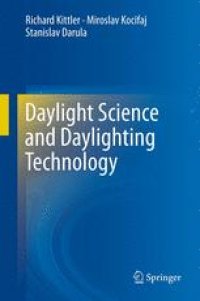
Ebook: Daylight Science and Daylighting Technology
- Tags: Optics Optoelectronics Plasmonics and Optical Devices, Renewable and Green Energy, Interior Architecture, Environmental Engineering/Biotechnology
- Year: 2012
- Publisher: Springer-Verlag New York
- Edition: 1
- Language: English
- pdf
Sunlight profoundly influences the Earth's atmosphere and biosphere. Nature fuels the evolution of all living things, their visual systems, and the manner in which they adapt, accommodate, and habituate.
Sun luminance measurements serve as data to calculate typical changes in the daily, monthly, and annual variability characteristics of daylight. Climate-based sky luminance patterns are used as models in predicting daylighting calculation and computer programs applied in architecture and building design. Historically, daylight science and daylighting technology has prioritized photometric methods of measurements, calculation, and graphical tools aimed at predicting or evaluating the daylighting of architectural design alternatives.
However, due to a heightened awareness of general health and well-being, sunlight exposure and freedom from visual discomfort while undertaking visual tasks are now equally prioritized. Therefore, in order to assure optimal environmental quality, daylighting technology must be based on sound science.
Daylight Science and Daylighting Technology, by Richard Kittler, Miroslav Kocifaj, and Stanislav Darula, sketches the entire evolution of daylight science from atmospheric science through apt visual workplace psychophysics.
Sunlight profoundly influences the Earth's atmosphere and biosphere. Nature fuels the evolution of all living things, their visual systems, and the manner in which they adapt, accommodate, and habituate.
Sun luminance measurements serve as data to calculate typical changes in the daily, monthly, and annual variability characteristics of daylight. Climate-based sky luminance patterns are used as models in predicting daylighting calculation and computer programs applied in architecture and building design. Historically, daylight science and daylighting technology has prioritized photometric methods of measurements, calculation, and graphical tools aimed at predicting or evaluating the daylighting of architectural design alternatives.
However, due to a heightened awareness of general health and well-being, sunlight exposure and freedom from visual discomfort while undertaking visual tasks are now equally prioritized. Therefore, in order to assure optimal environmental quality, daylighting technology must be based on sound science.
Daylight Science and Daylighting Technology, by Richard Kittler, Miroslav Kocifaj, and Stanislav Darula, sketches the entire evolution of daylight science from atmospheric science through apt visual workplace psychophysics.
Sunlight profoundly influences the Earth's atmosphere and biosphere. Nature fuels the evolution of all living things, their visual systems, and the manner in which they adapt, accommodate, and habituate.
Sun luminance measurements serve as data to calculate typical changes in the daily, monthly, and annual variability characteristics of daylight. Climate-based sky luminance patterns are used as models in predicting daylighting calculation and computer programs applied in architecture and building design. Historically, daylight science and daylighting technology has prioritized photometric methods of measurements, calculation, and graphical tools aimed at predicting or evaluating the daylighting of architectural design alternatives.
However, due to a heightened awareness of general health and well-being, sunlight exposure and freedom from visual discomfort while undertaking visual tasks are now equally prioritized. Therefore, in order to assure optimal environmental quality, daylighting technology must be based on sound science.
Daylight Science and Daylighting Technology, by Richard Kittler, Miroslav Kocifaj, and Stanislav Darula, sketches the entire evolution of daylight science from atmospheric science through apt visual workplace psychophysics.
Content:
Front Matter....Pages i-xxii
Introduction....Pages 1-4
Short Historical Review of Daylight Utilization by Living Creatures....Pages 5-43
Daylight Photometry: History, Principles, and Empirical Development....Pages 45-95
Propagation of Light in the Atmospheric Environment....Pages 97-125
Sky Luminance Characteristics....Pages 127-154
Simulation of Seasonal Variations in the Local Daylight Climate....Pages 155-186
Fundamental Principles for Daylight Calculation Methods....Pages 187-208
Analytical Calculation Methods and Tools for the Design of Unglazed Apertures....Pages 209-232
Daylight Methods and Tools to Design Glazed Windows and Skylights....Pages 233-255
Modeling Daylight Distribution in Complex Architectural Spaces....Pages 257-284
The Neurophysiology and Psychophysics of Visual Perception....Pages 285-309
Discomfort and Disability Glare in the Visual Environment....Pages 311-334
Back Matter....Pages 331-336
Sunlight profoundly influences the Earth's atmosphere and biosphere. Nature fuels the evolution of all living things, their visual systems, and the manner in which they adapt, accommodate, and habituate.
Sun luminance measurements serve as data to calculate typical changes in the daily, monthly, and annual variability characteristics of daylight. Climate-based sky luminance patterns are used as models in predicting daylighting calculation and computer programs applied in architecture and building design. Historically, daylight science and daylighting technology has prioritized photometric methods of measurements, calculation, and graphical tools aimed at predicting or evaluating the daylighting of architectural design alternatives.
However, due to a heightened awareness of general health and well-being, sunlight exposure and freedom from visual discomfort while undertaking visual tasks are now equally prioritized. Therefore, in order to assure optimal environmental quality, daylighting technology must be based on sound science.
Daylight Science and Daylighting Technology, by Richard Kittler, Miroslav Kocifaj, and Stanislav Darula, sketches the entire evolution of daylight science from atmospheric science through apt visual workplace psychophysics.
Content:
Front Matter....Pages i-xxii
Introduction....Pages 1-4
Short Historical Review of Daylight Utilization by Living Creatures....Pages 5-43
Daylight Photometry: History, Principles, and Empirical Development....Pages 45-95
Propagation of Light in the Atmospheric Environment....Pages 97-125
Sky Luminance Characteristics....Pages 127-154
Simulation of Seasonal Variations in the Local Daylight Climate....Pages 155-186
Fundamental Principles for Daylight Calculation Methods....Pages 187-208
Analytical Calculation Methods and Tools for the Design of Unglazed Apertures....Pages 209-232
Daylight Methods and Tools to Design Glazed Windows and Skylights....Pages 233-255
Modeling Daylight Distribution in Complex Architectural Spaces....Pages 257-284
The Neurophysiology and Psychophysics of Visual Perception....Pages 285-309
Discomfort and Disability Glare in the Visual Environment....Pages 311-334
Back Matter....Pages 331-336
....